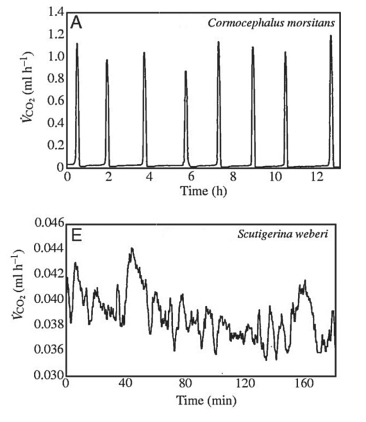Figure 33.2
Use the following information when answering the corresponding question(s) .
Many terrestrial arthropods exchange gases with their environments by using tracheae,tubes that lead from openings (called spiracles) in the animal's exoskeleton or cuticle directly to the animal's tissues.Some arthropods can control whether their spiracles are opened or closed;opening the spiracles allows the carbon dioxide produced in the tissues to travel down the tracheae and be released outside the animal.Klok et al.measured the carbon dioxide emitted over time (represented by VCO₂) by several species of centipedes.Figure 33.2 presents graphs of their results for two species,Cormocephalus morsitans and Scutigerina weberi.(C.J.Klok,R.D.Mercer,and S.L.Chown.2002.Discontinuous gas-exchange in centipedes and its convergent evolution in tracheated arthropods.Journal of Experimental Biology 205:1019-29. )

-Compare the graphs in Figure 33.2 of CO₂ emission for Cormocephalus morsitans and Scutigerina weberi.What hypothesis can you make about each centipede's habitat?
Definitions:
360-Day Year
An accounting convention that simplifies interest calculations by assuming all months have 30 days, resulting in a 360-day year.
Bond
A fixed income instrument representing a loan made by an investor to a borrower, typically corporate or governmental.
Purchase Cost
The total expense incurred to acquire an asset, including the purchase price and associated costs.
360-Day Year
A financial convention or simplification to treat all months as 30 days in duration for the ease of interest calculations and financial analysis.
Q7: Which of the following statements is consistent
Q9: Which of the following structural features of
Q16: If you were to design a countercurrent
Q17: What is necessary in order for symbiosis
Q20: Which tissue type,or organ,is not correctly matched
Q20: After mutagenesis and screening,you have found a
Q21: Which of the following do Nematoda and
Q30: Which of the following organisms would be
Q32: Which elements are most often the limiting
Q38: Plants produce more seeds when they reproduce